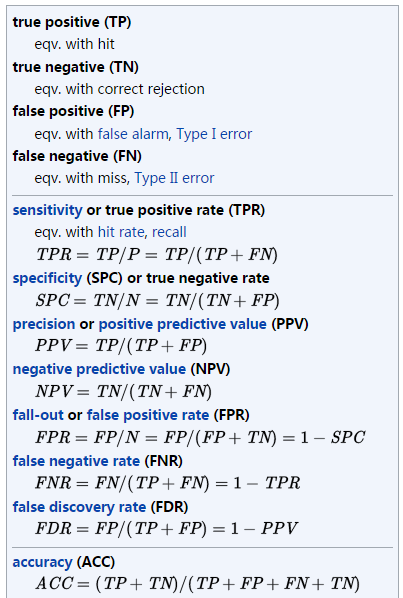敏感性、特异性、假阳性、假阴性(sensitivity and specificity) |
您所在的位置:网站首页 › 阳性和阴性是什么区别 › 敏感性、特异性、假阳性、假阴性(sensitivity and specificity) |
敏感性、特异性、假阳性、假阴性(sensitivity and specificity)
|
医学、机器学习等等,在统计结果时时长会用到这两个指标来说明数据的特性。 定义敏感性:在金标准判断有病(阳性)人群中,检测出阳性的几率。真阳性。(检测出确实有病的能力) 特异性:在金标准判断无病(阴性)人群中,检测出阴性的几率。真阴性。(检测出确实没病的能力) 假阳性率:得到了阳性结果,但这个阳性结果是假的。即在金标准判断无病(阴性)人群中,检测出为阳性的几率。(没病,但却检测结果说有病),为误诊率。 假阴性率:得到了阴性结果,但这个阴性结果是假的。即在金标准判断有病(阳性)人群中,检测出为阴性的几率。(有病,但却检测结果说没病),为漏诊率。 计算方法Sensitivity and specificity:完整定义
? 1 2 3 4 5 6 7 8 9 10 11 12 13 14 15 16 17 18 19 20 21 22 23 True Positive (真正, TP)被模型预测为正的正样本;可以称作判断为真的正确率 True Negative(真负 , TN)被模型预测为负的负样本 ;可以称作判断为假的正确率 False Positive (假正, FP)被模型预测为正的负样本;可以称作误报率 False Negative(假负 , FN)被模型预测为负的正样本;可以称作漏报率 True Positive Rate(真正率 , TPR)或灵敏度(sensitivity) TPR = TP /(TP + FN) 正样本预测结果数 / 正样本实际数 True Negative Rate(真负率 , TNR)或特指度(specificity) TNR = TN /(TN + FP) 负样本预测结果数 / 负样本实际数 False Positive Rate (假正率, FPR) FPR = FP /(FP + TN) 被预测为正的负样本结果数 /负样本实际数 False Negative Rate(假负率 , FNR) FNR = FN /(TP + FN) 被预测为负的正样本结果数 / 正样本实际数
假阳性率=假阳性人数÷金标准阴性人数 即: 假阳性率=b÷(b+d) 金标准金标准 阳性(+)阴性(-)合计某筛检方法阳性(+)aba+b某筛检方法阴性(-)cdc+d合计 a+cb+dN公式为:假阳性率=b/(b+d)×100% (b:筛选为阳性,而标准分类为阴性的例数;d:阴性一致例数) 假阴性率=假阴性人数÷金标准阳性人数 即: β=c÷(a+c) 终于要用到这个玩意了,很激动,主要统计假阴假阳性率。 我的任务: 1. 评估Pacbio MHC variation calling 结果(CCS/non-CCS)与Hiseq数据结果的一致性。 2. 分别在不同深度梯度的区域完成以上评估,推断PB MHC做variation calling的最低深度。 这里要将一个位点分为SNP、REF 和 LowQual,然后只去 SNP 和 REF 进行统计。 这是我一下午写出来的统计代码: ? 1 2 3 4 5 6 7 8 9 10 11 12 13 14 15 16 17 18 19 20 21 22 23 24 25 26 27 28 29 30 31 32 33 34 35 36 37 38 39 40 41 42 43 44 45 46 47 48 49 50 51 52 53 54 55 56 57 58 59 60 61 62 63 64 65 66 67 68 69 70 71 72 73 74 75 76 77 78 79 80 81 82 83 84 85 86 87 88 89 90 91 92 93 94 95 96 97 98 99 100 101 102 103 104 105 106 107 108 109 110 111 112 113 114 115 116 #!/usr/bin/env python # Author: LI ZHIXIN import sys import pysam from collections import OrderedDict def classify_DP(depth): if depth > 101 : return 21 return ((depth - 1 ) / / 5 + 1 ) def parse_rec(rec): sample = list (rec.samples)[ 0 ] # filter the Invalid line if not ( 'GQ' or 'GT' or 'DP' ) in rec.samples[sample].keys() or len (rec.alleles) 30 # variation_dict[rec.pos] = ["snp", rec.alleles] return rec.samples[sample][ 'DP' ], "snp" , rec.pos elif rec.samples[sample][ 'GT' ] = = ( 0 , 0 ): # variation_dict[rec.pos] = ["ref", rec.alleles] return rec.samples[sample][ 'DP' ], "ref" , rec.pos def read_gvcf(gvcf_file_path): variation_dict = OrderedDict() for i in range ( 1 , 22 ): variation_dict[i] = {} for j in ( 'LowQual' , 'snp' , 'ref' ): variation_dict[i][j] = [] # pos_list = [] gvcf_file = pysam.VariantFile(gvcf_file_path) for rec in gvcf_file.fetch( 'chr6' , 28477796 , 33448354 ): DP, pos_type, pos = parse_rec(rec) if DP < 1 or DP > 20 : continue # DP = classify_DP(DP) variation_dict[DP][pos_type].append(pos) # print(pos, DP, pos_type) gvcf_file.close() # return variation_dict, pos_list return variation_dict def read_hiseq_gvcf(gvcf_file_path): variation_dict = OrderedDict() # for i in range(1,22): # variation_dict[i] = {} for j in ( 'LowQual' , 'snp' , 'ref' ): variation_dict[j] = [] # pos_list = [] gvcf_file = pysam.VariantFile(gvcf_file_path) for rec in gvcf_file.fetch( 'chr6' , 28477796 , 33448354 ): DP, pos_type, pos = parse_rec(rec) DP = classify_DP(DP) variation_dict[pos_type].append(pos) # print(pos, DP, pos_type) gvcf_file.close() # return variation_dict, pos_list return variation_dict def show_dict_diff_DP(Hiseq_unified_variation_dict, PB_non_CCS_variation_dict, outf, outf2): for DP in range ( 1 , 21 ): Hiseq_snp = set (Hiseq_unified_variation_dict[ 'snp' ]) Hiseq_ref = set (Hiseq_unified_variation_dict[ 'ref' ]) Hiseq_lowqual = set (Hiseq_unified_variation_dict[ 'LowQual' ]) PB_snp = PB_non_CCS_variation_dict[DP][ 'snp' ] PB_ref = PB_non_CCS_variation_dict[DP][ 'ref' ] PB_lowqual = PB_non_CCS_variation_dict[DP][ 'LowQual' ] total = set (PB_snp + PB_ref + PB_lowqual) Hiseq_snp = total & Hiseq_snp Hiseq_ref = total & Hiseq_ref Hiseq_lowqual = total & Hiseq_lowqual PB_snp = set (PB_snp) PB_ref = set (PB_ref) PB_lowqual = set (PB_lowqual) a = len (Hiseq_snp & PB_snp) b = len (Hiseq_ref & PB_snp) c = len (Hiseq_lowqual & PB_snp) d = len (Hiseq_snp & PB_ref) e = len (Hiseq_ref & PB_ref) f = len (Hiseq_lowqual & PB_ref) g = len (Hiseq_snp & PB_lowqual) h = len (Hiseq_ref & PB_lowqual) i = len (Hiseq_lowqual & PB_lowqual) Low_total = (g + h + i) / (a + b + c + d + e + f + g + h + i) if (a + b) = = 0 : PPV = "NA" else : PPV = a / (a + b) PPV = "%.4f" % (PPV) if (a + d) = = 0 : TPR = "NA" else : TPR = a / (a + d) TPR = "%.4f" % (TPR) print ( str (DP) + " :\n" , a,b,c, "\n" ,d,e,f, "\n" ,g,h,i, "\n" , file = outf2, sep = '\t' , end = '\n' ) print (DP, TPR, PPV, "%.4f" % Low_total, file = outf, sep = '\t' , end = '\n' ) with open ( "./depth_stat.txt" , "w" ) as outf: print ( "Depth" , "TPR" , "PPV" , "Low_total" , file = outf, sep = '\t' , end = '\n' ) outf2 = open ( "raw.txt" , "w" ) Hiseq_unified_variation_dict = read_hiseq_gvcf( "./hiseq_call_gvcf/MHC_Hiseq.unified.gvcf.gz" ) PB_non_CCS_variation_dict = read_gvcf( "./non_CCS_PB_call_gvcf/MHC_non_CCS.unified.gvcf.gz" ) show_dict_diff_DP(Hiseq_unified_variation_dict, PB_non_CCS_variation_dict, outf, outf2) outf2
又碰到一个高级python语法:在双层循环中如何退出外层循环? 我用了一个手动的flag,有其他好方法吗? 如何统计下机数据的覆盖度和深度?当然要比对之后才能统计,而且还要对比对做一些处理。 在计算一个位点是否是SNP、indel、Ref时,不仅要考虑ref、alts、qual、GQ,而且必须要把GT、DP考虑在内,所以说还是比较复杂的。
最后如何分析第二个问题,call variation的最低深度? 统计不同深度下的假阴假阳性率,看在什么深度下其达到饱和。
|
【本文地址】
今日新闻 |
推荐新闻 |
